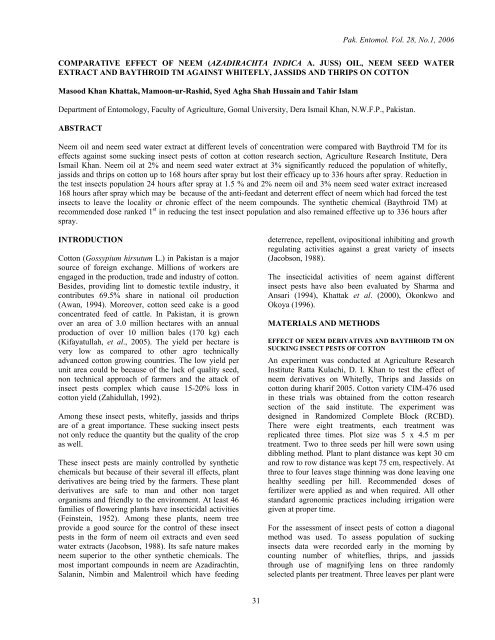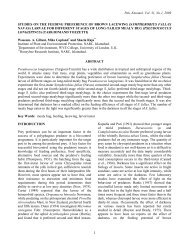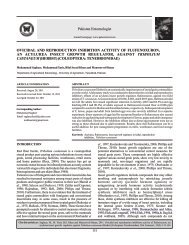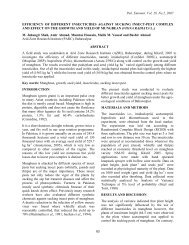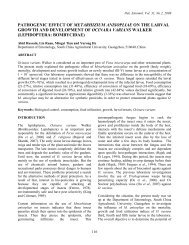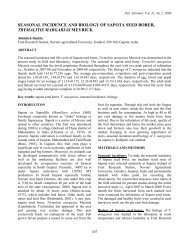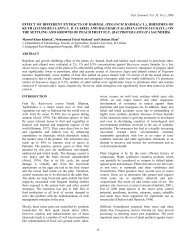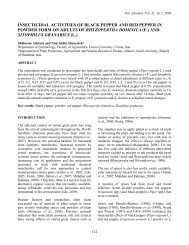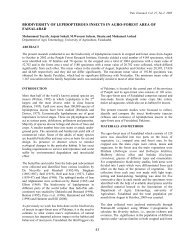comparative effect of neem (azadirachta indica a. juss)
comparative effect of neem (azadirachta indica a. juss)
comparative effect of neem (azadirachta indica a. juss)
- No tags were found...
Create successful ePaper yourself
Turn your PDF publications into a flip-book with our unique Google optimized e-Paper software.
Pak. Entomol. Vol. 28, No.1, 2006COMPARATIVE EFFECT OF NEEM (AZADIRACHTA INDICA A. JUSS) OIL, NEEM SEED WATEREXTRACT AND BAYTHROID TM AGAINST WHITEFLY, JASSIDS AND THRIPS ON COTTONMasood Khan Khattak, Mamoon-ur-Rashid, Syed Agha Shah Hussain and Tahir IslamDepartment <strong>of</strong> Entomology, Faculty <strong>of</strong> Agriculture, Gomal University, Dera Ismail Khan, N.W.F.P., Pakistan.ABSTRACTNeem oil and <strong>neem</strong> seed water extract at different levels <strong>of</strong> concentration were compared with Baythroid TM for its<strong>effect</strong>s against some sucking insect pests <strong>of</strong> cotton at cotton research section, Agriculture Research Institute, DeraIsmail Khan. Neem oil at 2% and <strong>neem</strong> seed water extract at 3% significantly reduced the population <strong>of</strong> whitefly,jassids and thrips on cotton up to 168 hours after spray but lost their efficacy up to 336 hours after spray. Reduction inthe test insects population 24 hours after spray at 1.5 % and 2% <strong>neem</strong> oil and 3% <strong>neem</strong> seed water extract increased168 hours after spray which may be because <strong>of</strong> the anti-feedant and deterrent <strong>effect</strong> <strong>of</strong> <strong>neem</strong> which had forced the testinsects to leave the locality or chronic <strong>effect</strong> <strong>of</strong> the <strong>neem</strong> compounds. The synthetic chemical (Baythroid TM) atrecommended dose ranked 1 st in reducing the test insect population and also remained <strong>effect</strong>ive up to 336 hours afterspray.INTRODUCTIONCotton (Gossypium hirsutum L.) in Pakistan is a majorsource <strong>of</strong> foreign exchange. Millions <strong>of</strong> workers areengaged in the production, trade and industry <strong>of</strong> cotton.Besides, providing lint to domestic textile industry, itcontributes 69.5% share in national oil production(Awan, 1994). Moreover, cotton seed cake is a goodconcentrated feed <strong>of</strong> cattle. In Pakistan, it is grownover an area <strong>of</strong> 3.0 million hectares with an annualproduction <strong>of</strong> over 10 million bales (170 kg) each(Kifayatullah, et al., 2005). The yield per hectare isvery low as compared to other agro technicallyadvanced cotton growing countries. The low yield perunit area could be because <strong>of</strong> the lack <strong>of</strong> quality seed,non technical approach <strong>of</strong> farmers and the attack <strong>of</strong>insect pests complex which cause 15-20% loss incotton yield (Zahidullah, 1992).Among these insect pests, whitefly, jassids and thripsare <strong>of</strong> a great importance. These sucking insect pestsnot only reduce the quantity but the quality <strong>of</strong> the cropas well.These insect pests are mainly controlled by syntheticchemicals but because <strong>of</strong> their several ill <strong>effect</strong>s, plantderivatives are being tried by the farmers. These plantderivatives are safe to man and other non targetorganisms and friendly to the environment. At least 46families <strong>of</strong> flowering plants have insecticidal activities(Feinstein, 1952). Among these plants, <strong>neem</strong> treeprovide a good source for the control <strong>of</strong> these insectpests in the form <strong>of</strong> <strong>neem</strong> oil extracts and even seedwater extracts (Jacobson, 1988). Its safe nature makes<strong>neem</strong> superior to the other synthetic chemicals. Themost important compounds in <strong>neem</strong> are Azadirachtin,Salanin, Nimbin and Malentroil which have feedingdeterrence, repellent, ovipositional inhibiting and growthregulating activities against a great variety <strong>of</strong> insects(Jacobson, 1988).The insecticidal activities <strong>of</strong> <strong>neem</strong> against differentinsect pests have also been evaluated by Sharma andAnsari (1994), Khattak et al. (2000), Okonkwo andOkoya (1996).MATERIALS AND METHODSEFFECT OF NEEM DERIVATIVES AND BAYTHROID TM ONSUCKING INSECT PESTS OF COTTONAn experiment was conducted at Agriculture ResearchInstitute Ratta Kulachi, D. I. Khan to test the <strong>effect</strong> <strong>of</strong><strong>neem</strong> derivatives on Whitefly, Thrips and Jassids oncotton during kharif 2005. Cotton variety CIM-476 usedin these trials was obtained from the cotton researchsection <strong>of</strong> the said institute. The experiment wasdesigned in Randomized Complete Block (RCBD).There were eight treatments, each treatment wasreplicated three times. Plot size was 5 x 4.5 m pertreatment. Two to three seeds per hill were sown usingdibbling method. Plant to plant distance was kept 30 cmand row to row distance was kept 75 cm, respectively. Atthree to four leaves stage thinning was done leaving onehealthy seedling per hill. Recommended doses <strong>of</strong>fertilizer were applied as and when required. All otherstandard agronomic practices including irrigation weregiven at proper time.For the assessment <strong>of</strong> insect pests <strong>of</strong> cotton a diagonalmethod was used. To assess population <strong>of</strong> suckinginsects data were recorded early in the morning bycounting number <strong>of</strong> whiteflies, thrips, and jassidsthrough use <strong>of</strong> magnifying lens on three randomlyselected plants per treatment. Three leaves per plant were31
Pak. Entomol. Vol. 28, No.1, 2006observed randomly and alternatively from top, middleand lower portion <strong>of</strong> the plants.The crop was sprayed four times at an interval <strong>of</strong> 20days. The first spray was carried out when the pestattack reached at Economic Threshold Level. Thethreshold level for sucking insects is as follows:Whiteflies 4-5 Adults/Crawlers per leafThrips 8-10 Adults/Nymphs per leafJassids 1-2 Adult/Nymph per leafEach <strong>neem</strong> derivative and pesticide was sprayed withknapsack hand operated sprayer. Pre-treatment datawas recorded 24 hours before spray and post treatmentdata was recorded 24 hours, 168 hours and 336 hoursafter spray to determine the <strong>effect</strong> <strong>of</strong> above mentionedchemicals.The mean populations <strong>of</strong> sucking insect pests fromsprayed plots were considered to be an indirectreflection <strong>of</strong> efficacy <strong>of</strong> different insecticides, thus alower mean value <strong>of</strong> population <strong>of</strong> insect pests afterspray reflected on a higher efficacy or toxicity <strong>of</strong> aninsecticide and vice versa. Percent population changewas calculated by using modified Abbot’s formulae(Fleming and Retnakaran, 1985) as below:Neem oil at 1% and <strong>neem</strong> seed water extract at 1% and2% did not show any significant decrease in the whiteflypopulation 24 hours after spray. However, a slightincrease in the population reduction at 2% <strong>neem</strong> seedwater extract, though, statistically similar was more thanPost treat. pop. Pre treat. popin treatment in check% population change= {1- (-----------------------x -------------------------)} x 100 x 100Pre treat. pop Post treat. Pop.in treatment in checkThus the final data were analyzed with Analysis <strong>of</strong>Variance (ANOVA) and means separated using LeastSignificant Different (LSD) test.Lay Out Plan <strong>of</strong> ExperimentR1 R2 R3T4 T2 T1T6 T5 T4T3 T8 T6T7 T3 T2T5 T4 T5T2 T1 T8T8 T7 T3T1 T6 T7Detail <strong>of</strong> TreatmentsT1 Neem oil 1%T2 Neem oil 1.5%T3 Neem oil 2%T4 Neem seed water extract 1%T5 Neem seed water extracts 2%T6 Neem seed water extracts 3%T7InsecticideT8ControlRESULTSEFFECT OF NEEM DERIVATIVES AND BAYTHROID TM ONTHE INFESTATION OF:Whiteflythat in the control. The 42.31% and 23.92% populationreduction at 2% <strong>neem</strong> oil and 3% <strong>neem</strong> seed waterextract, respectively, was significantly better than theother treatments except the treatment <strong>of</strong> insecticide,which showed the highest (85.35%) population reduction<strong>of</strong> the test insect (Table-1).Preparation <strong>of</strong> Neem Oil ConcentrationsNeem seed was collected from the local farmers <strong>of</strong> D.I. Khan and Bhakhar District. Neem oil from the <strong>neem</strong>seed was expelled by <strong>neem</strong> seed oil expeller. Differentconcentrations <strong>of</strong> the crude oil were prepared to beused in these trials.Preparation <strong>of</strong> Neem Water ExtractsTwo kilo grams dried <strong>neem</strong> seed collected from thelocal farmers was grinded. The grinded seed was tiedin a cotton cloth in the form <strong>of</strong> a bag and dipped in fiveliter <strong>of</strong> water at 80 0 C for 16 hours. In this wayconcentrated solution <strong>of</strong> 20% was obtained and dilutedto 1% 2 % and 3% for spray in the trials.The overall increase in the mean percent reduction inWhitefly population 168 hours after spray may bebecause <strong>of</strong> the <strong>neem</strong> antifeedant and deterrent <strong>effect</strong>,besides its toxicity to this insect at higher concentrations.A slight significant <strong>effect</strong> <strong>of</strong> <strong>neem</strong> oil 24 hours afterspray at 1.5% concentration increased to 45.64% up to168 hours after spray. The insecticide (Baythroid TM),366 hours after spray resulted into 31.27% mortality <strong>of</strong>the test insect, where <strong>neem</strong> oil and <strong>neem</strong> seed waterextract showed no significant reduction <strong>of</strong> the test insectpopulation 336 hours after spray.Similar results were obtained in the 2 nd , 3 rd and 4 th sprays(Table-2, Table-3 and Table-4). Neem oil and <strong>neem</strong> seedwater extract significantly reduced the test insectpopulation at higher concentrations up to 168 hours afterspray but lost their <strong>effect</strong>iveness up to 336 hours afterspray. A slight reduction in the population <strong>of</strong> test insectat 2% <strong>neem</strong> seed water extract was also similar as it was32
Pak. Entomol. Vol. 28, No.1, 2006in the first spray. Though, there was a gradual decreasein the efficacy <strong>of</strong> insecticide used in this study againstthe test insect, it remained <strong>effect</strong>ive up to 336 hoursafter spray; as 22.42%, 26.33%, and 29.27%population reduction in 2 nd , 3 rd and 4 th spray wasstatistically better than the other treatments.Table-1: Effect <strong>of</strong> <strong>neem</strong> derivatives and Baythroid TM on theinfestation <strong>of</strong> whitefly on cotton (1 st spray)TREATMENTSMEAN PERCENT EFFICACYNeem Oil 24 hours 24hours 168hours 336hoursbeforesprayaftersprayaftersprayafterspray1% 7.2 5.59E(6.57)3.27E(6.81)-0.12CD(7.03)1.5% 7 9.90D(6.22)45.64C(3.93)1.60C(6.7)2% 7.03 42.31B(3.93)55.06AB(2.83)7.00C(6.54)Nee Seed Water Extracts1% 6.16 6.50E(5.57)1.96E(6.17)-3.36D(6.24)2% 5.13 7.16DE(4.60)10.31D(4.68)1.35CD(4.94)3% 7.83 23.92C(5.76)51.26BC(3.92)2.38BC(7.46)Insecticide 6.33 85.35A(0.89)60.51A(2.90)31.27A(4.24)Control 8.43 4.5E(8.05)-5.83E(8.52)4.4CD(8.14)Each value is a mean <strong>of</strong> three replications. Means followed by thesame letters are not significantly different at α = 0.05Table-2: Effect <strong>of</strong> <strong>neem</strong> derivatives & Baythroid TM on theinfestation <strong>of</strong> whitefly on cotton (2 nd spray)TREATMENTSMEAN PERCENT EFFICACYNeem Oil 24 hours 24hours 168hours 336hoursbeforesprayaftersprayaftersprayafterspray1% (6.53) 2.78C(5.82)2.60D(6.08)-3.04D(6.53)1.5% (8.96) 4.58C(7.74)38.29B(5.29)1.79BC(8.52)2% (7.33) 32.05B(4.50)53.45A(3.31)3.04C(6.89)Neem Seed Water Extracts1% (5.76) -1.75C(5.29)2.94D(5.67)-3.29D(5.76)2% (6.06) -0.61C(5.60)13.08(5.25)-0.17C(5.98)3% (8.03) 24.46B(5.47)40.17B(3.08)2.88C(7.54)Insecticide (5.4) 87.87A(.59)58.10A(2.94)22.42A(4.05)Control 8.5 9.64C(7.68)5.41C(8.12)-1.33C(8.23)Each value is a mean <strong>of</strong> three replications. Means followed by the sameletters are not significantly different at α = 0.05Table-3: Effect <strong>of</strong> <strong>neem</strong> derivatives and Baythroid TM on theinfestation <strong>of</strong> whitefly on cotton (Third spray)TREATMENTSMEAN PERCENT EFFICACYNeem Oil 24 hours 24hours 168hours 336hoursbefore after after after sprayspray spray spray1% 5.53 3.40C(5.02)3.62CD(5.27)-2.12E(5.56)1.5% 6.36 6.72C(6.17)36.34B(5.32)2.34BCD(5.95)2% 8.43 36.16B(4.89)57.62A(2.87)4.56B(6.76)Neem Seed Water Extracts1% 6.56 -0.72C(6.47)-0.99D(6.39)-1.08DE(6.53)2% 6.00 2.61C(5.76)8.91C(4.98)1.29BCDE(5.71)3% 6.86 28.42B(4.55)42.27B(3.82)3.46BC(8.15)Insecticide 6.66 87.28A(1.06)57.80A(3.37)26.33A(3.59)Control 7.7 -0.12C(7.71)-3.14D(7.96)3.64CDE(7.68)Each value is a mean <strong>of</strong> three replications. Means followed by the sameletters are not significantly different at α = 0.05Table-4: Effect <strong>of</strong> <strong>neem</strong> derivatives and Baythroid TM on theinfestation <strong>of</strong> whitefly on cotton (Fourth spray)TREATMENTSMEAN PERCENT EFFICACYNeem Oil 24 hours 24hours 168hours 336hoursbeforesprayaftersprayaftersprayafterspray1% (5.33) -1.28EF(4.81)-4.80D(4.81)-3.58D(5.11)1.5% (5.63) 2.79D(4.20)31.65B(3.05)-2.05CD(5.37)2% (7.33) 37.70B(3.99)54.79A(2.66)2.16B(5.39)Neem Seed Water Extracts1% (5.63) -4.17F(5.14)-12.25E(5.21)-2.31CD(5.34)2% (4.96) 2.33D(4.31)6.28C(3.64)-2.74D(4.75)3% (6.06) 32.13C(3.59)51.21A(2.36)1.12BC(6.76)Insecticide (5.16) 82.48A(0.80)56.39A(1.81)29.27A(3.40)Control (7.26) 13.97DE(6.37)10.01D(5.79)-10.92BCD(6.5)Each value is a mean <strong>of</strong> three replications. Means followed by the sameletters are not significantly different at α = 0.05ThripsNeem derivatives at higher concentration greatly affectedthe test insect population, as <strong>neem</strong> oil at 2% and<strong>neem</strong> seed water extract at 3% reduced 33.7% and 29.1%33
Pak. Entomol. Vol. 28, No.1, 2006thrips population, respectively, 24 hours after spraywhich were statistically better than the populationreduction in the control (Table-5). However, BaythroidTM with 77.79% reduction ranked first in its efficacy.The insecticide, although, gradually lost its efficacy, itsignificantly control the test insect up to 336 hours.Neem oil at 1.5%, although, did not show any toxic<strong>effect</strong> against thrips 24 hours after spray, itsignificantly affected the test insect population 168hours after spray. The increase in the percent reduction<strong>of</strong> the insect population not only at 1.5% but also at 2%<strong>neem</strong> oil and 3% seed water extract 168 hours afterspray may be because <strong>of</strong> the antifeedant and deterrent<strong>effect</strong> <strong>of</strong> <strong>neem</strong> at these concentrations which hadforced the insect to leave the locality; However, thesetreatments lost their efficacy up to 336 hours. Againstthrips , <strong>neem</strong> seed water extract at 2% also showed aslight statistically better reduction <strong>of</strong> the test insectpopulation than in the control.All these treatments in the other applications behavedin similar fashion, as they did in the first applicationagainst the test insect. The synthetic insecticide rankedfirst in its efficacy and remained <strong>effect</strong>ive up to 336hours after spray. The <strong>neem</strong> derivatives <strong>effect</strong>ed theinsect population 168 hours after spray at higherconcentrations but completely lost their <strong>effect</strong> up to336 hours after spray (Table-6, 7, 8).Table-5: Effect <strong>of</strong> <strong>neem</strong> derivatives and Baythroid TM on theinfestation <strong>of</strong> thrips on cotton (First spray)TREATMENTSNeem oil 24 hoursbeforesprayMEAN PERCENT EFFICACY24hoursafterspray1% 13.93 -1.93C(13.44)1.5% 13.1 3.12C(11.72)2% 13.03 33.73B(8.26)Neem Seed Water Extracts1% 10.7 -2.21C(10.4)2% 9.63 -0.21C(8.99)3% 10.23 29.10B(6.87)Insecticide 10.46 77.79A(2.20)Control 12.56 5.36C(11.92)168hoursafterspray-2.83E(12.94)28.32C(8.65)57.43B(5.14)-6.48E(10.47)13.61D(7.72)51.82B(4.13)66.75A(3.23)2.84E(11.59)336hoursafter spray-8.49D(14.00)0.75BC(12.07)2.37B(11.23)-7.50CD(10.65)-3.27BCD(9.27)1.85B(9.39)33.88A(6.40)-0.25BCD(11.62)Each value is a mean <strong>of</strong> three replications. Means followed by thesame letters are not significantly different at α = 0.05.Table-6: Effect <strong>of</strong> <strong>neem</strong> derivatives and Baythroid TM on theinfestation <strong>of</strong> thrips on cotton (Second spray)TREATMENTSNeem Oil24 hoursbeforesprayMEAN PERCENT EFFICACY24hoursafterspray1% 10.46 -1.39D(10.23)1.5% 12.5 3.25C(11.72)2% 11.0 35.22B(6.88)Neem Seed Water Extracts1% 10.04 -2.51C(9.93)2% 10.43 2.28C(9.84)3% 10.00 32.77B(6.47)Insecticide 10.23 82.77A(1.72)Control 10.16 3.25C(9.84)168hoursafter spray-3.88DE(10.12)29.50B(8.2)60.97A(4.00)-7.33E(10.03)6.13C(9.18)57.06A(4.01)62.02A(3.62)3.14CD(9.54)336hoursafter spray-3.63C(10.58)0.85BC(12.08)1.93B(10.53)-3.83C(10.17)-2.30BC(10.43)1.68B(8.94)32.44A(5.99)-4.21BC(9.96)Each value is a mean <strong>of</strong> three replications. Means followed by the sameletters are not significantly different at α = 0.05Table-7: Effect <strong>of</strong> <strong>neem</strong> derivatives and Baythroid TM on theinfestation <strong>of</strong> thrips on cotton (Third spray)TREATMENTSNeem Oil24hoursbefore sprayMEAN PERCENT EFFICACY24 hoursafterspray1% 10.49 -4.05F(10.7)1.5% 12.53 1.56D(11.37)2% 10.35 38.26B(5.88)Neem Seedwater Extracts1% 10.44 -3.10EF(9.96)2% 10.26 0.74D(9.39)3% 10.3 31.80C(6.47)Insecticide 9.4 85.64A(1.24)Control 11.23 8.39DE(10.36)168hoursafterspray-7.81E(9.61)29.89B(7.45)58.60A(3.29)-10.87E(9.87)8.64C(7.95)55.87A(3.9)58.66A(3.62)8.70D(9.53)336hoursafterspry-13.58E(10.62)-5.56CD(11.80)1.91B(7.72)-9.80DE(10.27)-1.89BC(9.32)1.46B(9.05)28.24A(6.01)-4.89B(10.02)Each value is a mean <strong>of</strong> three replications. Means followed by the sameletters are not significantly different at α = 0.0534
Pak. Entomol. Vol. 28, No.1, 2006Table-8: Effect <strong>of</strong> Neem derivatives and Baythroid TM on theinfestation <strong>of</strong> thrips on cotton (Fourth spray)TREATMENTSNeem Oil24 hoursBeforesprayMEAN PERCENT EFFICACY24 hoursafterspray1% 11.78 -1.15D(11.27)1.5% 11.37 2.17D(10.53)2% 11.34 35.73B(6.91)Neem Seed Water Extracts1% 10.40 -1.21D(9.93)2% 9.62 1.53D(8.66)3% 11.25 31.01C(7.34)Insecticide 8.63 86.24A(1.12)Control13.45.76D(12.67)168 hoursafterspray-9.34E(11.39)32.21B(6.85)54.95A(3.44)-9.72E(10.1)9.01C(7.43)54.35A(4.56)56.91A(4.34)6.64D(11.88)336 hoursafterspray-8.62D(11.81)0.58B(10.60)1.89B(10.33)-5.55CD(10.13)-1.17BC(9.02)1.67B(10.23)29.17A(5.65)-4.27B(12.41)Each value is a mean <strong>of</strong> 3 replications. Means followed by the sameletters are not significantly different at α = 0.05.JassidsNeem derivatives at higher concentrations andBaythroid TM at recommended dose were as <strong>effect</strong>iveagainst jassids as these were <strong>effect</strong>ive against whiteflyand thrips (Table-9). Neem oil at 2% and <strong>neem</strong> seedwater extract at 3% reduced 37.89% and 31.31% insectpopulation, respectively, 24 hours after spray. Neem oilat 1.5%, although, did not target the pest population 24hours after spray, it significantly reduced the test insectpest population up to 168 hours after spray. Theincrease in the efficacy was also apparent in the 2%<strong>neem</strong> oil and 3% <strong>neem</strong> seed water extract 168 hoursafter spray. As mentioned earlier, this increase wouldbe because <strong>of</strong> the antifeedant and deterrent <strong>effect</strong>s <strong>of</strong><strong>neem</strong> derivatives at these concentration which hadcompelled the insect to leave the area. Baythroid TMas usual significantly reduced the test insect populationup to 336 hours after spray. Neem seed water extractsat 1% and 2% and <strong>neem</strong> oil at 1% were statisticallysimilar to figures in the control, however, <strong>neem</strong> seedwater extract at 2% slightly affected the test insectpopulation as it did in the other trials against whitefliesand thrips.All these treatments when applied 2 nd , 3 rd , and 4 th timeseach after 20 days interval showed identical efficacy tojassids; as they showed in the first application <strong>of</strong> thetreatments. Baythroid TM was more toxic at higherconcentrations and stayed toxic to the test insect forlonger period. Neem derivatives lost their efficacy up to336 hours after spray even at higher concentrations Table10, 11, and 12Table-9: Effect <strong>of</strong> <strong>neem</strong> derivatives and Baythroid TM on theinfestation <strong>of</strong> jassid on cotton (First spray)TREATMENTSNeem Oil24 hoursbeforesprayMEAN PERCENT EFFICACY24 hoursafterspray1% 1.20 -0.73DE(1.14)1.5% 1.52 2.88D(1.35)2% 1.73 37.89B(1.00)Neem Seed Water Extracts1% 1.53 -2.56E(1.48)2% 1.39 1.54DE(1.28)3% 1.62 31.31C(1.03)Insecticide 1.3 85.67A(0.17)Control1.465.79DE(1.38)168 hoursafterspray-3.52FG(1.13)31.31D(0.94)58.15B(0.65)-5.17G(1.46)6.98E(1.17)53.72C(0.67)64.05A(0.42)4.54F(1.32)336 hoursafter spray-2.39D(1.23)-0.44BCD(1.52)0.70BC(1.71)-2.20CD(1.56)-1.68BCD(1.41)1.05B(1.58)29.02A(0.92)-9.58BCD(1.46)Each value is a mean <strong>of</strong> three replications .Means followed by the sameletters are not significantly different at α = 0.05Table-10: Effect <strong>of</strong> <strong>neem</strong> derivatives and Baythroid TM on theinfestation <strong>of</strong> jassid on cotton (Second spray)TREATMENTSNeem Oil 24 hoursbeforesprayMEAN PERCENT EFFICACY24 hoursafterspray1% 1.82 -0.68CD(1.67)1.5% 1.66 1.62CD(1.50)2% 1.69 30.29B(1.11)Neem Seed Water Extracts1% 1.66 -2.45D(1.54)2% 1.41 2.54C(1.25)3% 1.2 30.54B(0.76)Insecticide 1.09 88.46A(0.11)Control 2.63 8.23CD(2.43)168 hoursafterspray-6.51F(1.76)33.03C(1.02)53.70B(0.71)-7.11F(1.60)9.11D(1.17)49.03B(0.56)62.05A(0.38)0.82E(2.41)336 hoursafter spray-6.00D(1.86)-0.49BCD(1.63)2.01B(1.32)-5.00CD(1.69)-1.04BCD(1.38)1.36BC(1.2)27.09A(0.78)-6.22BCD(2.57)Each value is a mean <strong>of</strong> three replications. Means followed by the sameletters are not significantly different at α = 0.0535
Pak. Entomol. Vol. 28, No.1, 2006Table-11: Effect <strong>of</strong> <strong>neem</strong> derivatives and Baythroid TM on theinfestation <strong>of</strong> jassid on cotton (Third spray)TREATMENTS MEAN PERCENT EFFICACYNeem Oil 24 hoursbeforespray24 hoursafterspray168 hoursafterspray336 hoursafterspray1% 1.74 -0.23D(1.67)-5.88G(1.62)-2.70C(1.72)1.5% 1.73 2.61D(1.61)36.49D(1.27)0.12BC(1.66)2% 1.93 37.17B(1.16)58.32B(0.70)0.32BC(1.85)Neem Seed Water Extracts1% 1.55 0.22D(1.47)-9.78G(1.49)-3.32C(1.52)2% 1.35 1.23D(1.28)8.86E(1.10)-2.02BC(1.34)3% 1.38 29.39C(0.93)47.92C(0.64)2.71B(1.30)Insecticide 1.39 91.92A(0.10)63.17A(0.45)30.67A(0.95)Control 2.13 4.41D(2.04)7.36F(1.9)-7.76BC(2.06)Each value is a mean <strong>of</strong> three replications. Means followed by thesame letters are not significantly different at α = 0.05Table-12: Effect <strong>of</strong> <strong>neem</strong> derivatives and Baythroid TM on theinfestation <strong>of</strong> jassid on cotton (Fourth spray)TREATMENTS MEAN PERCENT EFFICACYNeem Oil 24 hours 24 hours 168 hours 336 hoursbefore after after after sprayspray spray spray1%-1.25DE -8.37F -3.94DE1.46 (1.38) (1.39) (1.44)1.5%2.37D 29.52C -2.12CD1.63 (1.48) (1.01) (1.58)2%38.99B 56.35A 0.99BC1.65 (0.95) (0.63) (1.56)Neem Seed Water Extracts1%-3.92E -12.22F -6.83E1.71 (1.65) (1.66) (1.72)2%1.95DE 6.48D -1.39BCD1.750 (1.60) (1.43) (1.69)3%31.31C 48.79B 2.45B1.58 (1.01) (0.70) (1.46)Insecticide83.16A 58.16A 29.03A1.53 (0.28) (0.56) (1.01)Control7.38DE 6.84E -8.21BCD2.18 (2.03) (1.90) (2.07)Each value is a mean <strong>of</strong> three replications. Means followed by thesame letters are not significantly different at α = 0.05DISCUSSIONNeem oil at 1.5% and 2%, <strong>neem</strong> seed water extract at3%, and Baythroid TM at its recommended dosesignificantly reduced the mean percent infestation <strong>of</strong>cotton by whitefly, jassid and thrips. In Bangladesh,Islam (1983) found that the hexane extract <strong>of</strong> <strong>neem</strong>significantly deterred the feeding <strong>of</strong> brown planthopper and rice hispa. An ether and hexane extract <strong>of</strong><strong>neem</strong> seed reduced feeding activities by rice hispa andegg deposition by brown plant hopper in young riceseedling. Gupta and Sharma (1997) noted that in sprayschedule in which <strong>neem</strong> was used alternately withBacillus thuringienesis and synthetic pyrethroidsuccessfully managed Bemisia tabaci without itsresurgence. Neem seed extract and <strong>neem</strong> oil significantlyreduced the adult and nymphal populations <strong>of</strong> Bemisiatabaci.Neem derivatives at all concentrations lost their<strong>effect</strong>iveness upto 336 hours after spray, while BaythroidTM remained <strong>effect</strong>ive upto 336 hours after spray.Saxena et al. (1981a) demonstrated that <strong>neem</strong> derivativesdegrade faster in sunlight than in storage environmentand therefore, could provide satisfactory protection tostored grains against insect pests without requiringrepeated application. Khattak et al. (2000) investigatedthat the detrimental <strong>effect</strong> <strong>of</strong> the 1000ppm <strong>neem</strong> oiltreatment lost by 30 days after treatment but the10,000ppm treatment <strong>effect</strong>ively retained its antifeedantand deterrent <strong>effect</strong>s against maize weevil on cornkernels. Khan et al. (2002) demonstrated that <strong>neem</strong>extracts and insecticidal combinations significantlyreduced the population <strong>of</strong> thrips and bollworms on cotton17 days after spray. However, they showed gradualdecrease in their toxic <strong>effect</strong> against the test insects.Neem derivatives showed more reduction <strong>of</strong> the testinsect population 168 hours after spray as compared tothe reduction 24 hours after spray. This most probably bedue to the antifeedant and deterrent <strong>effect</strong> <strong>of</strong> <strong>neem</strong> whichwould forced the whiteflies, thrips and jassids to leavethe locality. Sexana et al. (1981b) found that <strong>neem</strong> oilwas good antifeedant for the control <strong>of</strong> rice brownhopper. Hoppers generally avoided the rice plantssprayed with 3%, 6% and 12% crude emulsified <strong>neem</strong>oil.ACKNOWLEDGEMENTSThe Principal author is highly indebted to HigherEducation Commission, Islamabad for full financialsupport <strong>of</strong> the studies, which for sure is in the interest <strong>of</strong>this nation. Thanks to Mr. Sultan Masood, In-chargeCotton Section, Agriculture Research Institute, RattaKulachi for providing research field for these trials.REFERENCESAwan, M.N., 1994. Evaluation <strong>of</strong> some insecticidalcombinations and <strong>neem</strong> extracts for the control<strong>of</strong> cotton pests (jassids, thrips, whiteflies andboll worms). Thesis, M. Sc. (Hons.) Agric.,Deptt. <strong>of</strong> Entomology, Faculty <strong>of</strong> Agri., GomalUniversity, D.I. Khan., pp: 92.36
Pak. Entomol. Vol. 28, No.1, 2006Feinstein, L., 1952. Insecticides from Plants. Insects(The Year Book). United States Department<strong>of</strong> Agriculture, Washington D. C., pp: 222-229.Gupta, G.P. and K. Sharma, 1997. Neem based pestmanagement strategy in cotton system. Pestic.Res. J., 9 (2): 190-197.Islam, B.N., 1983. Pesticidal action <strong>of</strong> <strong>neem</strong> andcertain indigenous plants and weeds <strong>of</strong>Bangladesh. Natural pesticides from the <strong>neem</strong>tree and other tropical plants. P. 263-290.Jacobson, M., 1988. Focus on phyto-chemicalpesticides. Vol:1. The Neem tree. CRC Inc.Boca Raton, Florida, USA. 178 pp.Khan, L., M.K. Khattak, M.N. Awan and A.S.Hussain, 2002. Comparative efficacy <strong>of</strong> <strong>neem</strong>(Azadirachta <strong>indica</strong>. A. Juss) extracts andcertain insecticidal combinations againstthrips and boll worms on cotton. Gomal Uni.J. Res., 19: pp 251-258.Khattak, M.K., A.B. Broce and B. Dover, 2000. Eggdevelopmental inhibition and ovipositionaldeterrence <strong>of</strong> Neem or Mineral oil on Maizeweevil, Sitophillus zeamais Motsch. Pak. J.Biol. Sc., 3(11): 1910-1913.Kifayatullah, K. Khan, A.R. Soomro, Z. Mehmood,M. Illahi, N. Soomro and S.R. Soomro, 2005.Cotton production in Pakistan: CurrentScenario. The Indus Cotton, 2(1): 59-66.Okonkwo, E.U. and W.I. Okoya, 1996. The efficacy <strong>of</strong>four seed powders and the essential oils asprotectant <strong>of</strong> cowpea and maize grains infestedby Callosobruchus maculates (F). (Coleaptra:Bruchidae) and Sitophilus zeamais (Motsch.)(Coleoptera: Curculionidae) in Nigeria. Inter. J.Pest Manag., 42: 143-46.Saxena, R.C., G.P., Wald baver, N.J. Liquido and B.C.Puma, 1981b. Effect <strong>of</strong> <strong>neem</strong> oil on the rice leaffolder, (Naphalocrocis medinalis) pp. 157-170.In H. Schmutter, K.R.S. Ascher and H.Rembold (ed.), Natural pesticides from the<strong>neem</strong> tree (Azadirachta <strong>indica</strong> A. Juss).Proceeding, First Inter. Neem Conf., Germany.Agency for Technological Co-operation, Berlin,Germany.Saxena, R.C., N.J. Liquido and H.D. Justo. 1981a.Neem oil a potential antifeedant for the control<strong>of</strong> rice brown hopper, Nilaparvata lugens, pp.177-188. In H. Schmutter, K.R.S. Ascher andH. Rembold (ed.), Natural pesticides from the<strong>neem</strong> tree (Azadirachta <strong>indica</strong> A. Juss).Proceeding, First Inter. Neem Conf., Germany.Agency for Technological Co-operation, Berlin,Germany.Sharma, V.P. and M.A. Ansari, 1994. PersonnelProtection from mosquitoes (Diptera: Culicidae)by burning <strong>neem</strong> oil in kerosene. J. Med.Entomol., 31: 505-507.Zahidullah, 1992. Population dynamics <strong>of</strong> insect pests<strong>of</strong> cotton in Dera Ismail Khan and chemicalcontrol <strong>of</strong> bollworms. M.Sc. (Hons.) Agri.Thesis, Fac. Agri., Gomal Uni. D.I. Khan. 56pp.37


